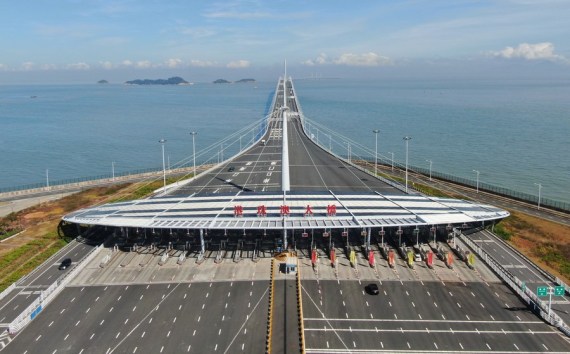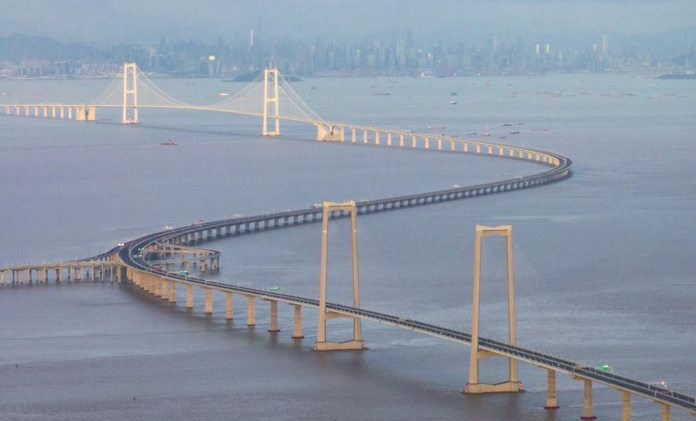The recent opening of the Shenzhen-Zhongshan Link, together with the operation of the Hong Kong-Zhuhai-Macau Bridge, and the deepening cooperation between Macau and Hengqin are pointing to a new and significant direction in South China: the inevitability of territorial integration between Hong Kong and Shenzhen’s borderland areas and between Macau and Hengqin around 2047 and 2049 respectively, with significant implications for Xiamen’s future relations with Kinmen.

The most recent opening of the Shenzhen-Zhongshan Link has geopolitical and socio-economic significance for South China. The 24-kilometer passage not only starts at the strategic Shenzhen airport interchange and connects with Ma’anshan Island in Zhongshan across the Pearl River, but also reduces the travel time between Zhongshan and Shenzhen from two hours to only 30 minutes. The megaproject has one underwater tunnel, two bridges and two artificial islands, becoming a key transportation connector located just 30 kilometres north of the famous Humen Bridge and 31 kilometres south of another megaproject, namely the Hong Kong-Zhuhai-Macau Bridge. These three transportation networks can be seen as the most important hallmark of infrastructure integration in the Pearl River Estuary. As Deng Xiaohua, the head of Guangdong Provincial Communications Group, said, these bridges provide the “cross-sea and cross River passages in the Greater Bay Area (GBA), boosting connectivity of the city cluster.”
In short, all the main cities in the GBA are now more conveniently interconnected, providing a solid foundation of deeper territorial integration in South China. All these cities are expected and required to interact more intensively in economic cooperation, bringing about an economic powerhouse collectively in South China in the coming years.
If territorial integration is defined as a combined process of geographical, social and economic reengineering that makes the regional boundaries more fluid, porous and flexible with the ease of entry and exit of regional residents and even foreigners, then the recent and ongoing infrastructure transformations in the Pearl River Estuary are very geopolitically significant, including a recent mainland policy of allowing non-Chinese residents of Hong Kong and Macau to apply for mainland visit permits.
Hong Kong is now connected easily with the mainland through the High-Speed West Rail, the Hong Kong-Macau-Zhuhai Bridge and the nearby Qianhai Cooperation Zone, which is expected to forge closer collaboration with the Hong Kong Special Administrative Region (SAR) in their service, financial and information technology sectors in the coming years.
Macau’s metamorphosis is even much faster than Hong Kong. With the deepening and raid process of economic and social integration with Hengqin, more Macau people are moving to live in the new Macau Neighborhood in Hengqin. Macau has also been empowered by the central government in Beijing to possess more territorial waters and even to absorb 3,700-square-metre plot of land from Zhuhai to build the eastern line of the Light Rail Transit system. As of March 2024. Macau’s total land area was expanded to 33.3 square kilometres. Macau’s physical space has been expanded and will be augmented further sooner or later if the first line of Hengqin, where goods from Macau are tax-exempted, will quite likely be territorially absorbed into Macau perhaps around or after 2049.
The economic and governing implications for Hong Kong and Macau are obvious. While Hong Kong has to reposition itself as an indispensable part of Shenzhen’s rapid development, including Qianhai where start-up companies have mushroomed and unleashed the innovative potential of youths from the mainland and Hong Kong, the development of the Northern Metropolis has to be accelerated so that Hong Kong’s borderland with Shenzhen will become increasingly populated and more economically prosperous, with its higher education, information technology and research hubs being constructed as soon as possible. Otherwise, without a much faster timeline, Hong Kong would likely lag behind the very rapid pace of territorial integration in South China, especially in contrast with the speed in which Macau has been increasingly socially and economically integrated with Hengqin.

The implication for the Hong Kong authorities is that they must design and formulate plans of, say, building a bridge or a tunnel linking Shenzhen with San Tin area, which according to the Northern Metropolis Action Agenda in 2023 will have a projected population of 147,000 to 159,000 by 2033. The Hong Kong SAR government must also speed up all the action plans from now to 2033 if territorial integration is actually a long-term developmental plan in South China in the psyche of central authorities.
Similarly, Hong Kong must accelerate and deepen the collaboration of high-end professional services and logistics supply chains with the Qianhai Cooperation Zone, including an earlier construction of the Hong Kong-Shenzhen Western Rail Link connecting Hung Shui Kiu in Yuen Long with Qianhai. The Hong Kong Island West-Hung Shui Kiu Rail Link should ideally be speeded up if the Hong Kong authorities sense the inevitability of territorial integration between Hong Kong and Shenzhen. The Northern Metropolis Highway should also be a priority of infrastructure development in the New Territories. Otherwise, any delay in infrastructure development and completion may point to a gap in territorial integration, whereby Macau’s territorial integration with Hengqin will likely be much faster than Hong Kong’s full integration with Shenzhen’s borderland.
Positively, the Hong Kong Mass Transit Railway (MTR) is planning to build 12 railway lines and some 30 new stations, reducing the travel time within Hong Kong and improving its interconnectedness with Shenzhen. These lines include the Hong Kong Island, Lantau Island. Northern Metropolis and the New Territories. In fact, the new stations in Northern Metropolis and New Territories must be accelerated toward the inevitable thrust of territorial integration.
Overall, Shenzhen is well positioned to become perhaps the politically reliable and indeed the most important economic locomotive in South China, assisted by Hong Kong’s strong financial and monetary centre and Macau’s unique tourism hub. Shenzhen, with its strong GDP growth rate of 5.5 percent, is expected by the central authorities to be a strategic, high- ended, technologically innovative megacity that offers high-quality services, model public health and high environmental standards with sustainability. The central authorities have been eager to shape Shenzhen, with immense efforts from its local officials, into a national information technology centre, attracting talents from Hong Kong and elsewhere and becoming an influential consumption centre and foreign investment magnet.
As such, the division of labour in South China is becoming more prominent than ever before: Hong Kong is to strengthen its international financial and monetary centre with its solid common-law system attracting foreign investment while retaining its role as a superconnector; Macau is to transform itself into an economically diversified economy away from casino capitalism while consolidating its platform function for China to enhance economic and diplomatic relations with Portuguese-speaking countries; and Shenzhen is to continue using Qianhai as a bridgehead to accelerate the process of internationalizing Renminbi and to build up its GBA insurance service centre.
Under these circumstances, Hong Kong and Macau must accelerate their infrastructure projects, maintain socio-political stability (which explains why national security is extremely important to both SARs), govern their regions with demonstrated capability to tackle livelihood issues (housing, social welfare, poverty alleviation sustainable development), and quickly reposition their strategic roles amid the motherland’s developmental blueprint.
The other important but perhaps neglected implication for territorial integration in South China is that the central authorities appear to adopt a similar strategy of utilizing infrastructure development in dealing with a small part of Taiwan, notably Kinmen where a bridge on the Xiamen side connecting Kinmen has already begun. Although the bridge has expectedly aroused political debate in Taiwan, it seems that a silent process of stage-by-stage integration between parts of Fujian (Xiamen) and a small part of Taiwan (Kinmen) would likely take place sooner or later, with the shadows mirroring the models of Macau-Hengqin cooperation and Hong Kong-Shenzhen collaboration.
In conclusion, territorial integration in the Pearl River Estuary, including Hong Kong’s cooperation with Shenzhen’s borderland and Macau’s integration with Hengqin, is clearly emerging. A formal process of territorial integration, specifically absorbing parts of the territories from one region to another place, will quite likely occur between the Macau SAR and Hengqin around 2049, and it would also perhaps take place between the Hong Kong SAR and Shenzhen’s selected borderland (like Qianhai) around or after 2047. Macau’s territorial integration with Hengqin appears to proceed in a much faster pace, judging from the currently rapid pace and smaller but targeted scope of co-development with Hengqin due to geographical proximity and an immediate implementation of physical integration and focused residential migration. The long-term geopolitical and economic implications of the Macau and Hong Kong models of integration with the mainland for a possible Xiamen-Kinmen integration cannot be neglected. The reason is that a similar pattern of infrastructure development preceding human interactions and economic cooperation is beginning with the construction of the Xiamen side of the bridge linking Xiamen with Kinmen. If this analysis is accurate, then this new bridge will likely be part of a stage-by-stage process of socio-economic integration between the mainland and Taiwan in the coming years. What is unique in the model of Hong Kong/Macau integration with the mainland is that their political reunification with the motherland in 1997 and 1999, respectively, preceded infrastructure expansion and integration. In the case of mainland China’s attempt at integration with Taiwan, it appears that infrastructure development is now an important inception leading to perhaps closer economic cooperation and more human interactions, followed hopefully and ideally by a stage-by-stage but difficult process of political dialogue, negotiations and perhaps integration and reunification.
*Sonny Shiu-Hing Lo is a political scientist, veteran commentator, and author of dozens of books and academic articles on Hong Kong, Macau, and Greater China




















